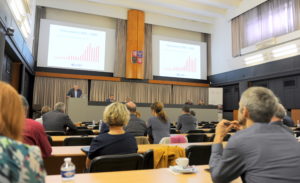 The use of lasers in the Army of the Czech Republic and selected research, development and production capabilities of companies and institutions operating in the Czech optical cluster and new trends in the defense industry responding to the current security situation. These were the main topics discussed at the workshop organized by the Czech Optical Cluster at the University of Defense in Brno on September 22. 2022. At the beginning of the meeting, the rector of the University of Defense, Zuzana Kročová, highlighted the benefits of cooperation between institutions and entities associated in the Czech optical cluster and the necessity of more intensive scientific and research cooperation in this area.
The use of lasers in the Army of the Czech Republic and selected research, development and production capabilities of companies and institutions operating in the Czech optical cluster and new trends in the defense industry responding to the current security situation. These were the main topics discussed at the workshop organized by the Czech Optical Cluster at the University of Defense in Brno on September 22. 2022. At the beginning of the meeting, the rector of the University of Defense, Zuzana Kročová, highlighted the benefits of cooperation between institutions and entities associated in the Czech optical cluster and the necessity of more intensive scientific and research cooperation in this area.
Representatives of the University of Defense, commercial subjects and research and development institutions presented their contributions on interesting topics, their common denominator being the topic of lasers and their use not only for military purposes. Teodor Baláž from the University of Defense dealt with the issue of Lasers in the Army of the Czech Republic. Filip Chlup from PRAMACOM-HT spoke about laser protection. Michael Písařík from HILASE presented Lasers and optics in anti-drone defense. Multispectral and hyperspectral systems and the issue of camouflage were presented by František Racek from the University of Defense. Michal Košelja spoke about the application of laser technology and their components in weapon systems. Pavel Honzátko from the Institute of Photonics and Electronics of the Academy of Sciences of the Czech Republic presented powerful fiber lasers and their interesting potential for use.
Jiří Hynek, president of the Defense and Security Industry Association, mentioned an important aspect of the transfer of research and development findings into practice, for which the cooperation of industry with universities and research and development centers is very important.
Many interesting suggestions and information were heard at the workshop, and especially the connection with the events in Ukraine shows that this security area cannot be underestimated and that the cooperation of representatives of companies, universities and scientific institutions is crucial for future technological development.

